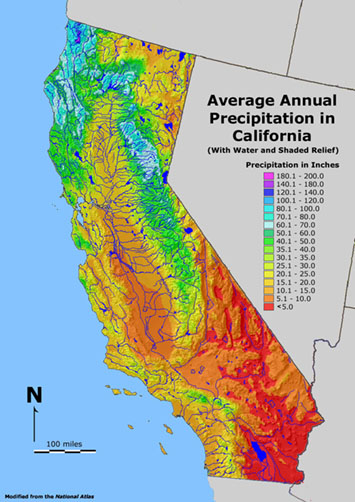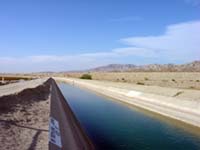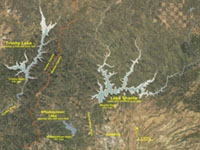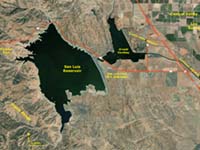
California's Interconnected Water System |
California's State Water Project (SWP)California's State Water Project (SWP) was constructed in the 1960s and 1970s. It's system of interconnected reservoirs, canals, aqueducts, pipelines was designed to supply water to more than 27 million people and 750,000 acres of farmland. However today, with almost 40 million residents, California is the most populous state in the United States. California's largest consumer of water is its extensive agriculture industries in the Central Valley and Imperial Valleys. It is now referred to as the California Water System.The California Water System is the world's largest, most productive, and most politically controversial water system in North America and possibly in the world (Figure 2). The political battles involve water rights to the distribution of water for agriculture, urban/municipal usage, and conservation of watersheds to preserve natural ecosystems. Roughly 3/4 of the California's population of about 40 million people rely on water from the California Water System. |
Click on images for a larger view! |
Fig. 1.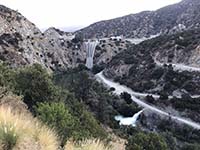 Morris Reservoir Dam in San Gabriel Mountains |
The California Water System IllustratedThe vast majority of the water consumed in California that isn't taken from the Colorado River is water from the snow melt and precipitation falling on the Sierra Nevada Mountains and Coast Ranges of Northern California (Figure 5). Most of the rivers draining from these regions have been dammed, and their water discharge is closely managed or largely diverted into the network of canals, aqueducts, and pipelines that supply water to California's municipalities and for agriculture. Figures 6 to 10 illustrate some of these massive man-made infrastructure features.Politics and Water in CaliforniaIt can't be understate just how much politics can play when it comes to water resources here in California (and to practically anywhere in the world today with a limited water supply). Managing water is extremely expensive. Just in California, it is estimated that water management agencies spend more than $30 billion every year on water—that is equivalent to about $2,350 per household.The California Department of Water Resources (DWR) and the California State Water Resources Control Board (SWRCB) are the two state government organizations that conduct water research and propose legislation related to water use, infrastructure, and conservation for the state. Figure 11 shows the Hetch Hetchy Valley in Yosemite National Park before and after construction of Hetch Hetchy Reservoir. With widespread environmental destruction in the Sierra Nevada caused by the Gold Rush and logging, conservations fought to preserve what they could, and Yosemite National Park established in 1890. However, the political feud for water and resources did not stop. The Sierra Club was established in 1892 (both as a social and political action organization). However, after a long battle, preservationists lost a fight, and on December 19, 1913, President Woodrow Wilson signed a bill authorizing the Hetch-Hetchy Project. The project's goal of providing safe, clean drinking water to the San Francisco Bay Area. The public outcry led to increased public awareness about protecting scenic and sacred lands. This effort helped establish the National Park Service in 1916. |
||
Fig. 5 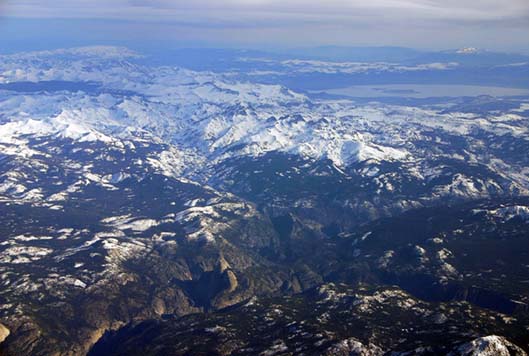 Precipitation (mostly snow) and runoff from the Sierra Nevada Range varies considerably from one year to the next. This airliner view is near Yosemite NP. |
Fig. 6. 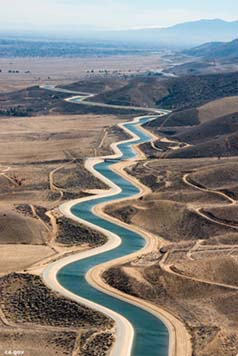 California Aqueduct winds along the foothills near Palmdale. |
Fig. 7.  Water from the California Aqueduct gets pumped to Los Angeles. |
Continue to the next page (a look at San Diego County's natural water supply).A) Where Does San Diego Get Its Water?B) The Colorado River Drainage Basin C) California's Interconnected Water System D) San Diego County's Natural Water Supply E) The San Dieguito River Watershed F) Water Conservation G) Assignment Tasks & Questions |
| https://gotbooks.miracosta.edu/earth_science//California_Water_Systems.html | 6/29/2020 |

